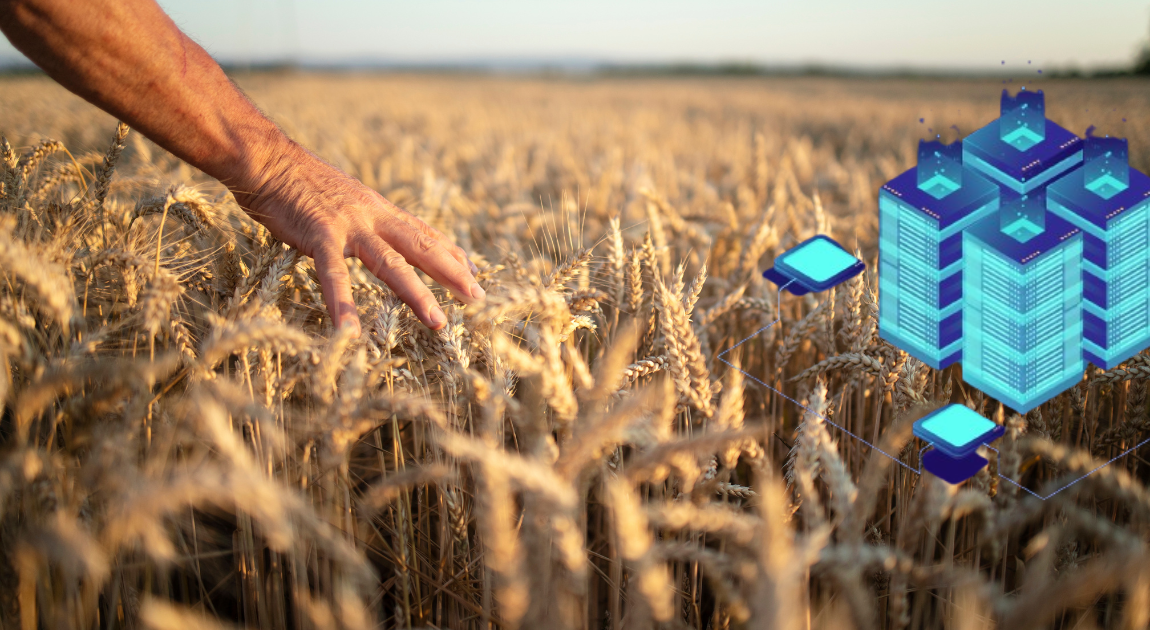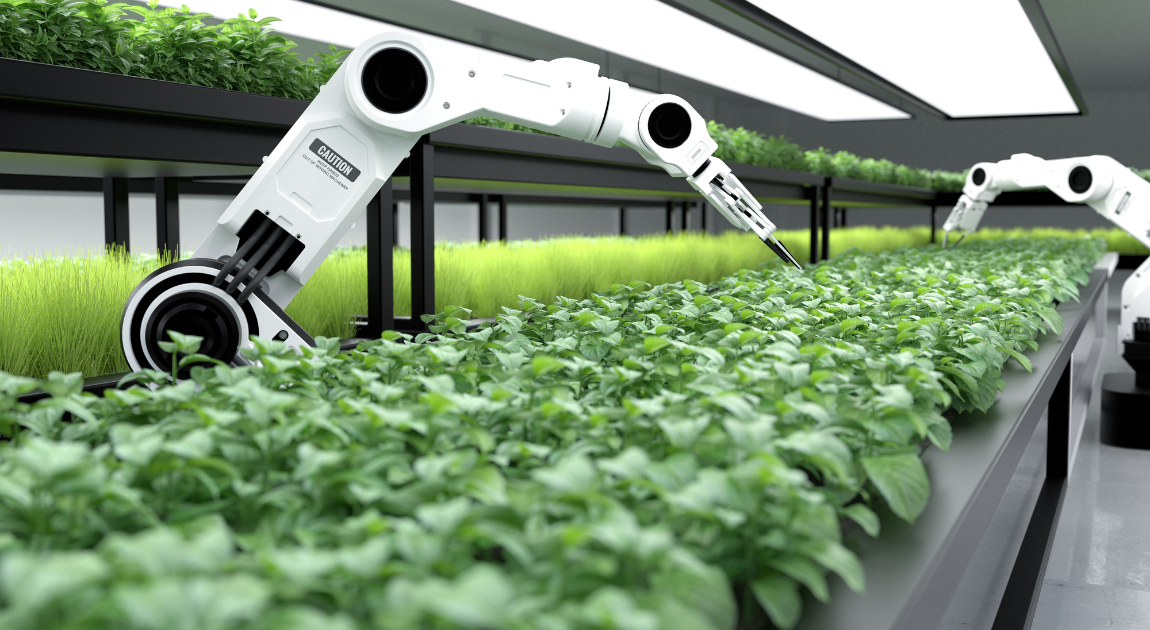Back when GenX and millennials were kids and teens tinkering with now-obsolete PC models, there would often be someone who’d say that was nowhere near a real job at a farm. Ironically, modern farming is now one of those areas that even looks differently year after year. Agricultural machinery has evolved into data-driven models, while concerns about the environmental impact of global food production push farmers to cultivate new crops in new ways. Food production is becoming tech-infused, but also more sustainable – while increasing profitability. Let’s look at the ten main trends and recent innovations shaping the future of agriculture for the rest of this decade and further on.
What’s driving agriculture innovation at the moment
Sometimes tech can evolve first, probably spurred by scientific advancements or demands from other industries, and then people just transplant the new practices into, say, agriculture. But with agri-food, the external factors are often strong enough to dictate the tech evolution.
Climate is one such factor. It may seem as though humanity has progressed past the times when weather was everything for harvest, but it’s only partially correct. In the UK, for example, 4 out of 5 farmers report that extreme weather has harmed their productivity, with 84% having seen crop yields drop. In general, climate change is said to be able to reduce yields by 11.2% as we reach 2099, even in regions like the US Midwest.
Meanwhile, the world’s population is expected to come to 9 billion by the middle of the century – and the accompanying urbanization also means farmland loss. Even now, almost 29% of the global population are facing moderate or severe food insecurity. The solution? Trying to squeeze more food out of smaller land areas.
Not just smaller land areas, too, but also smaller inputs in general – smarter resource use. Fertilizer prices surged in early 2025, TSP up 43%, DAP up 23%, not to mention fuel prices. Naturally, farmers faced with less-than-satisfactory profit margins are rather investing into ways to improve ROI than walking on the slippery slope of dependency on volatile pricing.
At the same time, consumers are developing interest in where the food comes from, so traceability is another area of improvement, spurring blockchain development in the agricultural industry.
These factors call for digital solutions, and tech already helps a lot, but it also has its own prerequisites – at the very least, internet access. As of now, there’s still a significant digital divide, especially when it comes to certain places where, say, bananas and coffee is grown – and the current stage of development is essentially testing what works where digital infrastructure is already in place, and gaining new footholds everywhere else.
Governments, of course, are also involved, offering carbon credits, sustainability subsidies, and digital compliance mandates. Businesses, too, are adapting collaboratively: startups creating niche solutions, cooperatives making platforms affordables, and enterprises investing in R&D and custom tech.
Sustainable practices and crop efficiency: is it a dilemma?
From afar, sustainability and crop efficiency might seem at odds, but curiously, in 2025, the divide seems to be disappearing rather quickly.
For example, regenerative farming is proving itself scalable. Project Drawdown’s meta-analysis of regenerative (“conservation agriculture”) practices estimated net profit of about US$530.39/ha/year for regenerative annual cropping versus US$474.21/ha/year for conventional systems (based on pooled studies)..
In India, using AI for precision application of fertilizers allowed to reduce urea use by 15-20% without sacrificing rice or wheat yields. Vertical farming is developing in the Netherlands quite successfully, too.
The important takeaway here is that technology seems to have unlocked the scalability problem for sustainable farming, and it’s becoming both environmentally friendly and profitable given the right data is fed to the systems.
With that in mind, let’s look at some of the most evident tech-related trends and innovations in the agricultural sector in more detail.
#1 Advancement of AI-driven precision agriculture
Before AI, precision farming was quite a tough task, with loads of data to process manually, while real-time decision making was typically out of the question. Things have changed in the more “doable” direction, though. AI can now detect pest risk, crop yield, and disease with up to 95–98% accuracy, and their adoption has increased by 67% over the past three years.
Success cases abound: companies like Spotta in the UK and Agtellio in the US use a combination of IoT and AI for precise VRA of pesticides and fertilizers. In Kenya, AI tools allowed farmers to nearly triple coffee yields and optimize pest control and management.
You can learn more about the Agtellio case and Lionwood.software’s collaboration here.
#2 Remote sensing and drones becoming widespread
Hardware is becoming more ubiquitous, too, including drones and remote sensing tech. The transition from experimental to essential is underway, as the agriculture drone market is projected to hit $8B by the end of the decade.
In addition to more widespread use, drones are “learning” new things, too, like multispectral and hyperspectral imaging, swarm coordination, and edge processing. Governmental action is also underway across multiple countries, from an Indian program that saw use of drones for spraying 2,500 acres in Uttar Pradesh to Argentinian and Spanish moves towards simplifying drone licensing.
#3 Data-driven DSSs with agriculture specialization
DSS, that is, decision support systems, are now gaining agricultural specialization and becoming a promising farm tech type. They empower farmers to make evidence-based choices about planting, pest management, irrigation, crop protection, and yield optimization.
One notable case is DSSAT, which is used across >100 countries to simulate crop growth based on soil, weather, crop health, and choices of farming practices. Apart from that, there are other early examples like a recommendation system that boosted cotton yield by 12-17% through casual inference-based planning.
#4 Blockchain for agri-food supply chain transparency
Although the crypto boom of several years ago caused some exhaustion from blockchain-related “buzzwords”, the technology itself has matured and become more useful than many could imagine initially. In agri-food supply chains, it helps solve longstanding challenges like food security, fraud, and origin tracking, not to mention supporting fair trade principles.
Best practices include traceability systems with QR codes that allow consumers to see the product’s journey from farm to shelf, like OpenSC or Silal Fresh – as well as monetizing farm data through licensing.
You can read more about the use of blockchain in agriculture in another post on our blog.
#5 Vertical farming and other unconventional practices
What started as a rather niche, almost hobby-like, realm of experiments is now viewed more seriously. The global vertical farming market is at $6.2 billion as of 2025, and is growing at a projected CAGR of 19.7% (2024-2029). The geography is also expanding – from hipster-managed urban microfarms in Europe, the practice is now taking the Asia-Pacific and Middle Eastern regions by storm. For example, Madar Farms in the UAE produce tomatoes in desert conditions with 20% of the usual amount of water, thus shortening the supply chain (which makes sense seeing as how tomatoes are perishable). Hydroponics, aquaponics, regenerative container farms and the like are making a spectacular entrance into the big industry.
#6 Livestock tech and wearables – tentative evolution
While crop-focused agtech takes up most of the headlines, livestock technology is evolving in the background, too – maybe more cautiously but steadily enough. The trend is partly driven by animal health and welfare regulations, on the one hand, and labor shortages, on the other.
Automation is a good answer to both, since it also allows capturing data for monitoring. Wearables and sensors for early disease detection, as well as sustainability, are being tested across different locales. The Irish product, Moocall, for example, uses sensors to predict calving time, while the Dutch CowManager monitors fertility, health, and nutrition. Herd management in general is most readily digitized, with poultry following suit.
Discover a case study about the implementation of herd management software in the US here.
#7 Autonomous tractors and robotics
In 2023, we saw John Deere’s 9R autonomous tractor with 360-degree cameras and GPS becoming commercially available. Since then, autonomous machinery has been evolving and filling ever more functions, as a response to both labor shortage issues and interest for precision farming.
And it’s not just tractors, but robotics, too, like the French vineyard and vegetable robots for autonomous weeding by Naïo, of which about 500+ units are said to have been deployed in Europe and North America.
For some uses, further development of swarm robotics is expected, lowering soil compaction and distributing tasks more efficiently. Additionally, aerial and ground-based units that handle targeted spraying are being tested in Japan, Brazil, and the U.S.
#8 Regenerative agriculture development
There’s also more interest in regenerative agriculture, which is distinct from organic farming in aiming to restore soil health, biodiversity, and ecosystem function while driving profit. In other words, instead of exploiting or sustaining the land, regenerative agriculture is about improving it with minimized tillage, cover cropping, natural fertilization, agroforestry and other practices.
In 2023, Nestlé, Unilever, and General Mills invested millions into regenerative pilot programs with their supply chain partners to reduce Scope 3 emissions. Then, regenerative methods were adopted on over 15M hectares globally by late 2024. As part of that trend, tech came pouring in, with satellite/drone monitoring, carbon tracking platforms, and IoT sensors.
#9 Demand for irrigation tech and smarter water usage management
More than half of all arable land in the world is estimated to experience water stress at least once per growing season. Agriculture accounts for over 70% of global freshwater withdrawals, so smart irrigation is in demand.
Today’s solutions have progressed past the drip line/sprinkler stage, too, into data-driven automated systems for variable rate irrigation. The watershed moment (pun unintended) came with the introduction of moisture sensors and AI/ML, which amplify the approach. For instance, Netafim’s Precision Irrigation-as-a-Service, used in >30 countries, combines IoT with software and consulting services to cut water usage by up to 40%.
In fact, these developments are very much akin to precision agriculture and VRA approaches, so the development of algorithms and general methods is coming fast on the heels of the sibling domain.
#10 Growing system interoperability
Finally, since the modern farm’s digital toolsheds are growing, there’s the question of how to achieve interoperability between these tools. After all, it’s not so much a separate digital solution or device that’s generating value but rather the way they work together. Imaging technologies furnish data for decision making systems, robotics function based on it and supplement it in real time, and so on. In essence, the resulting ROI is not calculated with an x+y+z formula, but rather something that looks like x⋅y^z in reality, so interrelations matter a lot.
As a response, there are multiple efforts and initiatives to bridge gaps and work towards unified ecosystems, like the ADAPT framework by AgGateway, which is an open-source standard for agricultural data integration. Even John Deere have started opening parts of their software to third-party integrations via John Deere Operations Center API. There are also the ISOBUS standards, supported by Trimble and CNH Industrial.
While this process is slow, custom agriculture software developers are already taking notes and building solutions with interoperability in mind.
Main takeaways: working towards efficient and sustainable future
The next few years will likely see the agriculture and food industry continue its rapid digital transformation, not as a niche innovation playground, but as a full-fledged, data-driven industry where environmental sustainability and economic viability are no longer opposing goals.
At the same time, the industry is maturing in how it thinks about technology – shifting focus from isolated “cool tools” to integrated ecosystems where hardware, software, and biological practices work in concert. This growing interoperability, coupled with smarter water use, regenerative approaches, and livestock monitoring, points to a farming future that is not only more productive but also more resilient against climate, market, and resource challenges.
The bottom line? The farms of 2030 may look drastically different from those of 2020, but their mission will remain the same: feed a growing population, protect the land, and do both in ways that make economic sense. The difference now is that technology, rather than being a luxury, has become the essential enabler of that mission.
At Lionwood.software, we design and develop custom software solutions tailored to the needs of modern agriculture — from precision agriculture platforms to farm management systems and IoT integrations. You can contact us for consultations and start building the tools that make your farm or agribusiness future-ready.














